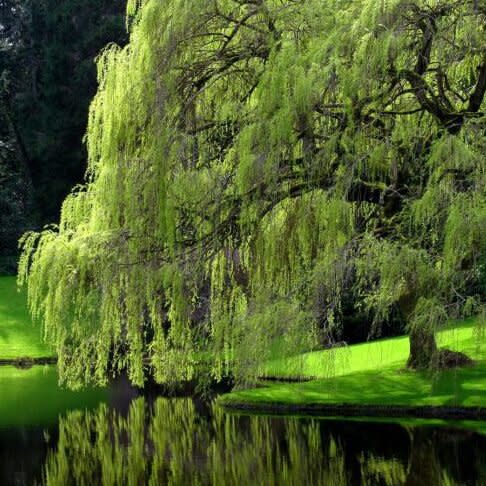The Only Good Place For a Weeping Willow

The only site a weeping willow should be suffered to live. Photo: Christina Salwitz. Photo thief: Grumpy
The weeping willow (Salix babylonica), sometimes also called Babylon willow, is a polarizing plant. While some adore this unique-looking tree for its droopy charm, others believe that enjoying the sight of a weeping willow in your yard will never be worth the hassle. Outside of China, where it originates, the weeping willow has not had much success with being cultivated, aside from certain hybrid derivatives. The tree is easy to grow and fast to take root—able to propagate in many types of soil—but it is hard to keep alive.
Courtesy of my friend, Seattle garden blogger and garden designer, Christina Salwitz, you are looking at the only kind of place a weeping willow should ever be planted. On the banks of a pond or lake with nothing else around. With the owner's house, driveway, sidewalk, pool, water lines, septic tank, pet cemetery, and all the neighbor's houses very far away—50 feet or more. To refuse this advice is to court disaster.
Let me be blunt: If you plant a weeping willow anywhere in the suburbs or any other environment without ample space for it to grow, the best you can hope for is that it will die quickly. And there is a good chance that it will.
Why Weeping Willow Doesn't Work in Neighborhoods
It grows very fast; often more than three feet per year. During a particularly rainy year, they may grow even more. On the face of it, that might seem like a good thing, but fast-growing trees—think willows, poplars, silver maple, mulberry—are the products of aggressive, wide-spreading, shallow root systems. The weeping willow root system can spread up to three times the height of the tree itself, and these shallow roots go on to crack pavement, damage foundations, protrude above the soil, and invade water lines. Needless to say, this can create a significant amount of problems and stress for homeowners, from extra yard work to the potential cost of extensive repairs to the home. Plus the wood of just about any tree that grows lightning-fast is sure to be weak, which means it tends to break very easily during storms, creating even more clean-up for you.
It needs lots of water. This is why the weeping willow looks its best near a body of fresh water. It's also why its roots snake into sewer lines and septic tanks, giving you a wonderful surprise when you flush the first time in the morning. Though weeping willow roots will not "seek out" these things, the roots will spread more easily in soil where it detects moisture. So sewer lines, plumbing, and septic tanks that have cracks are more likely to be invaded. On the other hand, if you plant weeping willow in drier soil in an attempt to keep the root system from spreading and creating so much devastation in your yard, the tree sulks. However, it can tolerate loamy, clay-like, and sandy soils. Regardless of the soil type, it should be more acidic than alkaline.
It grows too big for most yards. A weeping willow can grow more than 40 feet tall and can spread itself just as wide. Moreover, its branches sweep the ground, which means it's probably going to end up swallowing your entire yard. And unless you regularly prune the pendulous branches to head height, forget about lounging under there.
It's a target for just about every insect and disease pest. The list is a long one, but here are just a few of the things a weeping willow can be home to: gypsy moths, sawflies, beetles, lace bugs, Lymantria dispar, aphids, spider mites, and carpenterworms. Some of the diseases to look out for are willow scab, black canker, leaf spot, various foliar diseases, crown gall, and willow gall. The tree also attracts grazers like rabbits, beavers, and deer.
All of the above is why you will never encounter an ancient, 500-year-old weeping willow. If they don't die quickly from being planted in an area not conducive to its need for space, weeping willows have a short lifespan of about 40-75 years.
Weeping willow may look striking and provide brilliant fall color to a yard, but its dramatic beauty may not be worth all the trouble it takes to keep it alive and protect everything around it from its wildly spread root system. Therefore, let us resolve to consign this tree to the only place it belongs. Beside a large body of fresh water with nothing else around.
